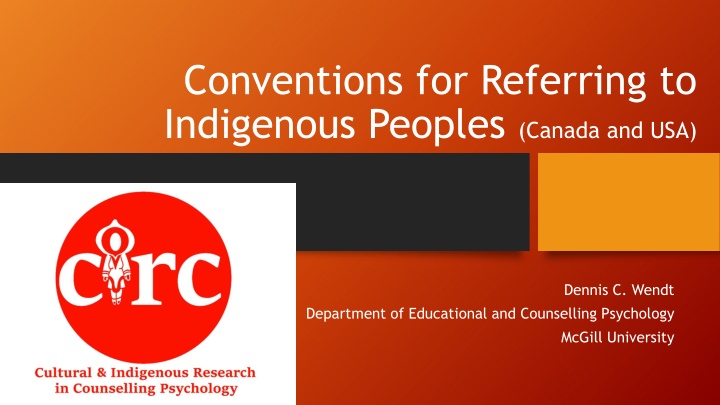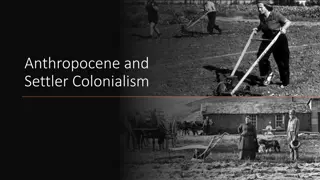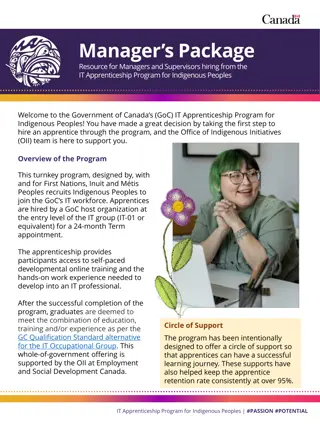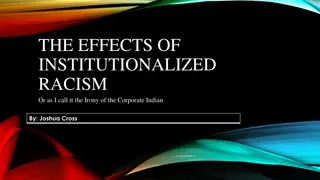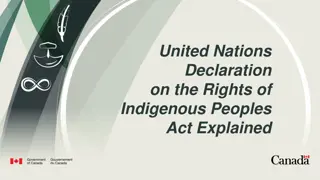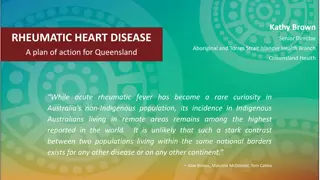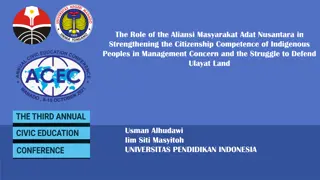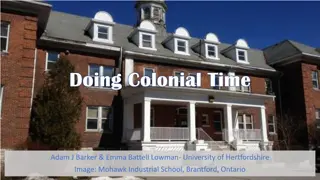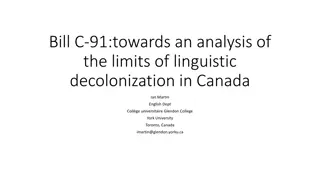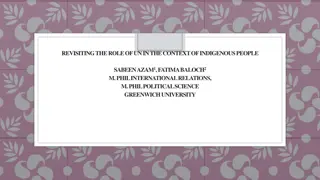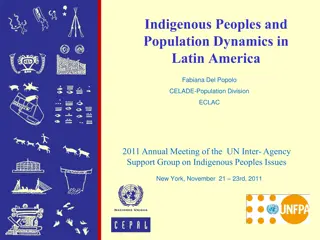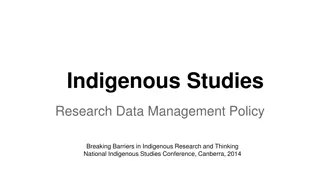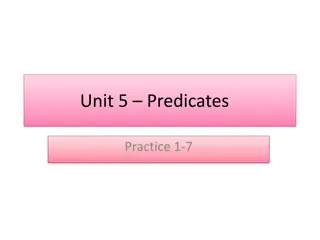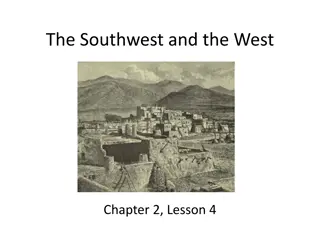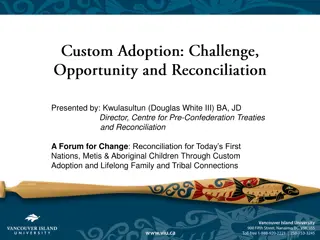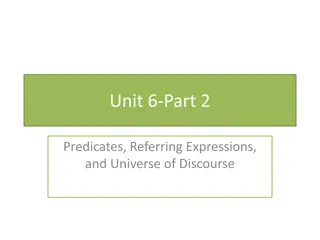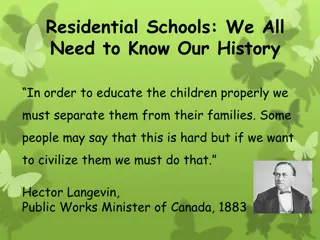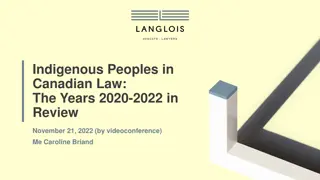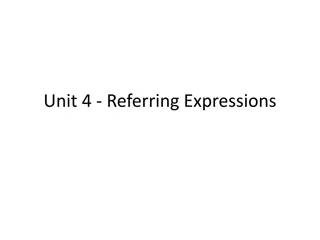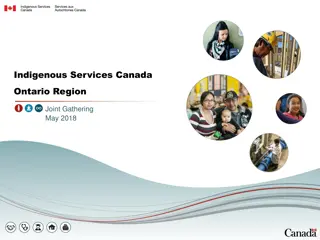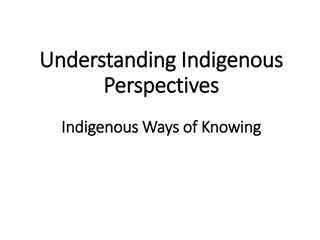Conventions for Referring to Indigenous Peoples in Canada and the USA
This article outlines guidelines for referring to Indigenous Peoples, emphasizing specificity and respect for preferred names and terms. It discusses the importance of capitalizing terms related to Indigenous Nations and cautions against using terms implying colonial possession. The use of terms like "Indigenous" and "First Nations" is highlighted, along with recommendations for language use in Canada and beyond.
Download Presentation

Please find below an Image/Link to download the presentation.
The content on the website is provided AS IS for your information and personal use only. It may not be sold, licensed, or shared on other websites without obtaining consent from the author.If you encounter any issues during the download, it is possible that the publisher has removed the file from their server.
You are allowed to download the files provided on this website for personal or commercial use, subject to the condition that they are used lawfully. All files are the property of their respective owners.
The content on the website is provided AS IS for your information and personal use only. It may not be sold, licensed, or shared on other websites without obtaining consent from the author.
E N D
Presentation Transcript
Conventions for Referring to Indigenous Peoples (Canada and USA) Dennis C. Wendt Department of Educational and Counselling Psychology McGill University
General Principles Be as specific as possible e.g.: A Cree woman instead of an Indigenous woman Use names and terms that Indigenous Nations themselves prefer These increasingly differ from historically more familiar post-contact names, although those often are still widely used and acceptable Kanien keh :ka is generally preferred over Mohawk Anishinaabeg is generally preferred over Algonquian Lnu or Mi kmaq are generally preferred over Micmac
General Principles (continued) Trend towards capitalizing terms referring to Indigenous Nations, institutions, identities, certain traditions, ceremonies, and rights (in English) e.g.: Indigenous, Chief, Elder, Clan, Medicine Man, the Creator, Oral Tradition, Indigenous Right, Treaty Right, Sweat Lodge Note, however, there is not a consensus on capitalization; style guides and usages vary Some terms may be appropriate for certain Indigenous individuals to use, but are not generally appropriate for non-Indigenous individuals to use Do not use terms that imply colonial possession of Indigenous Peoples Not: Canada s Indigenous Peoples or Indigenous Peoples of Canada Instead: Indigenous Peoples in Canada or Indigenous Peoples of what is now called Canada
Indigenous (autochtone) When referring to Indigenous Peoples broadly within Canada (and increasingly in other countries, including the U.S.) Indigenous Peoples Indigenous individuals Indigenous communities Indigenous Nations Do not use if a more specific term can be used (e.g., Inuit or Naskapi ) Can also be used to refer to Indigenous Peoples globally In Canada (and increasingly in the U.S.) it is helpful to specify global use, to avoid confusion: e.g., Indigenous Peoples around the world French: preferred term is autochtone (Gerdaud, 2016) For plural use, I recommend peuples autochtones (but autochtones is acceptable)
First Nations (Premires Nations) Indigenous Peoples in Canada who are not M tis or Inuit Status and non-status Indians under the Indian Act First Nations came into common use in 1970s to replace Indian Have historical and contemporary ties/kinship with Native American Tribes Plural as an adjective or when referring to persons A First Nations girl He is First Nations ; they are First Nations Singular when referring to the name of an individual Nation Peguis First Nation
Inuit Indigenous Peoples of the Arctic regions of Canada, Greenland, and Siberia Alaska Native(s) : for Indigenous Peoples in Alaska Not: Eskimo Inuit means the people, so: Correct: Inuit have hunted Incorrect: The Inuit have hunted or Inuit people have hunted But: les Inuit is correct in French Can be used as an adjective An Inuit agreement Inuk : singular for an individual The woman is Inuk They are Inuit
Mtis Used to refer to a post-contact Indigenous People that emerged during the fur trade and were at the centre of the Red River Resistance (1869-70) and the Red Resistance (1885). Although the ancestors of contemporary M tis include First Nations women married to French-Canadian men, M tis does not refer simply to anyone who has one Indigenous parent and one non-Indigenous parent Note: Canada defines M tis in terms of the M tis National Council, which recognizes certain peoples rooted in western/central Canada (especially MB, AB, SK, NT; to some extent BC and ON), but not in QC or Atlantic Canada (see Leroux, 2019) Can be used as an adjective or as a singular or plural noun A M tis woman Alberta has designated land for the M tis He is M tis They are M tis Remember the accent ( )
Aboriginal Generally acceptable but increasingly outdated umbrella term for Indigenous Peoples in Canada Use when referring to specific organization names Royal Commission on Aboriginal Peoples Network for Aboriginal Mental Health Research Montreal Urban Aboriginal Community Strategy Network Used as part of predominant umbrella term in Australia Aboriginal and Torres Strait Islander peoples Note: Aborigine is outdated and increasingly seen to be offensive Use as an adjective, not as a noun Aboriginal Peoples Not: An Aboriginal or Aboriginals
Indian (indien): Canada Avoid (in general) Use to refer to certain policies and historical terms Indian Act ( Loi sur les Indiens ) Indian Residential School system ( Pensionnat indien ) Can be used to refer to Indian Act status Status Indian(s) under the Indian Act NDN : online slang used by some First Nations and Native American individuals Avoid if you are not Indigenous (Montreal Urban, 2019)
Indian: United States More acceptable in the U.S. (vs. Canada) Preferred label for some Still used in some institutional names: e.g., Indian Health Service, Bureau of Indian Affairs, Society of Indian Psychologists Indian Country is commonly used to refer to reservation and reservation- adjacent lands Still, avoid term on its own (especially if you are not Indigenous) American Indian and Alaska Native Peoples Federal umbrella terms for Indigenous Peoples in the U.S. Sometimes abbreviated as AIAN or AI/AN American Indian : generally (but not universally) accepted; often used interchangeably with Native American
Amerindian (amrindien) Outdated anthropology term to refer to Indigenous Peoples throughout the Americas; avoid More common in French, but increasingly outdated e.g., term replaced by autochtone in 2018 in Quebec high school history textbooks (Canadian Press, 2018)
Native Generally avoid within Canada, especially if you are not Indigenous More acceptable in the United States: Native as an adjective Native American(s) : probably the most predominant umbrella term in the U.S. Native Hawaiian(s) Native traditions, Native languages, etc. Still, avoid Native(s) as a noun, especially if you are not Indigenous Except: Alaska Native(s)
BIPOC Refers to Black Peoples, Indigenous Peoples, People(s) of Colour or Black, Indigenous, and people of color Has been used to highlight how living in a culture of white supremacy impacts all folx of colour; popular in activist and academic writing (SFU Library, 2021) Sometimes used to prioritize or emphasize Black and Indigenous Peoples collectively as especially marginalized Not widespread consensus on use American Psychological Association s (2021) Inclusive Language Guidelines : discourage, preferring people/persons of color and communities of color (p. 10) Simon Fraser University Library (2021) guide on Inclusive and Antiracist Writing : Discusses advantages and drawbacks of the term; notes recommendation to use racialized instead
Nation(s) Widely accepted (and probably preferred) term to refer to Indigenous groups as sovereign political entities Preferable to (colonial) terms that do not necessarily imply sovereignty, such as: clan(s) But appropriate to use as uppercase, Clan, when part of a governance structure band(s) Though still frequently used, especially for legal uses in association with the Indian Act tribe(s) But often the preferable term in the United States; should be capitalized ( Tribe(s) )
Reserve(s) Tracts of land set aside for Indigenous Nations (predominantly status Indians under the Indian Act), in negotiation with the Crown Residency can be described as on-reserve or off-reserve United States: reservation
Instead of say this legends / myths / tales : Oral Traditions or Traditional Stories ritual(s) Ceremony / Ceremonies land claim(s) Indigenous Title(s) artifact(s) Describe the item peace pipe Sacred Pipe (Younging, 2018)
Other Considerations Do not: Refer to European settlers discovering Indigenous lands Instead: arrived, landed, made contact Refer to an Indigenous Nation s ongoing ceremonies, traditions, activities, etc., in the past tense Unless referring to a specific time period, event, etc. Use pow wow casually to mean a generic meeting or gathering Use totem pole casually to refer to a position in a hierarchy (e.g., avoid statements like, she is low on the totem pole )
Other Considerations Avoid: The use of spirit animal in a casual way disconnected from Indigenous spiritual traditions (APA, 2021) Referring to Indigenous languages as extinct Instead: no living (or current) speakers Note: Languages can be revived and are frequently viewed to be living (e.g., in a spiritual sense) even if there are no living speakers.
Other Considerations Be wary of: Romanticism i.e., Assuming that traditional Indigenous life is/was innocent, beyond reproach, in perfect harmony with nature, etc. Cultural essentialism i.e., Assuming there is such thing as a single authentic Indigenous culture (In general, I recommend not using culture as a noun) Extreme pity or catastrophizing i.e., Exaggerating the negative impact of colonization (e.g., as irreparably devastating), alongside ignoring or minimizing the resilience or survivance of Indigenous Peoples Decontextualized pathologizing i.e., Attributing deficits to individuals or communities, alongside ignoring or minimizing their strengths as well as the social context of disparities
Racist, Offensive Terms WARNING: The following slide lists racist terms that are offensive I am following Chelsea Vowel and Gregory Younging in listing such terms I have learned from experience that not everyone is aware that all of these terms are offensive Note: Some Indigenous individuals might occasionally use some of these terms to refer to themselves (e.g., for strategic, artistic, or humorous reasons) If so, that does not give non-Indigenous people a license to use these terms
Racist, Offensive Terms barbarian brave buck Chief (used casually/inappropriately) half-breed (race mixte) heathen Indian giver pagan primitive redman redskin (peau rouge) savage (sauvage) squaw uncivilized
References American Psychological Association. (2021). Inclusive language guidelines. https://www.apa.org/about/equity-diversityinclusion/language-guidelines.pdf Canadian Press (2018, September 27). Quebec spends $1.6 M editing history textbooks to use proper Indigenous terms. CBC News. https://www.cbc.ca/news/indigenous/quebec- editing-textbooks-indigenous-terms-1.4841285 Gerdaud, S. (2016, March). De l usage des termes indig ne et autochtone . De la plume l' cran. https://delaplumealecran.org/spip.php?article22 Leroux, D. (2019): Distorted descent: White claims to Indigenous identity. University of Manitoba Press. Montreal Urban Aboriginal Community Strategy Network (2019). Indigenous ally toolkit. http://reseaumtlnetwork.com/resources/ Native American Journalists Association (2018). Reporting and Indigenous terminology. https://najanewsroom.com/wp- content/uploads/2018/11/NAJA_Reporting_and_Indigenous_Terminology_Guide.pdf
References (continued) R seau pour la strat gie urbaine de la communaut autochtone Montr al (2019). Trousse d'outils pour les alli es aux luttes autochtones. http://reseaumtlnetwork.com/fr/ressources/ Simeone, T. (2015, December). Peuples autochtones: terminologie et identit . Notes de la Colline. Research et analyse de la biblioth que du Parlement du Canada. https://notesdelacolline.ca/2015/12/14/peuples-autochtones-terminologie-et- identite/ Simon Fraser University Library (2021, November 10). Black Peoples, Indigenous Peoples, People(s) of Colour (BIPOC): Inclusive and antiracist writing. https://www.lib.sfu.ca/about/branches-depts/slc/writing/inclusive-antiracist- writing/bipoc#steps-for-inclusive-writing-about-peoples-of-colour-andor-black-peoples- andor-indigenous-peoples- Vowel, C. (2016). Indigenous writes: A guide to First Nations, M tis and Inuit issues in Canada. HighWater Press. Younging, G. (2018). Elements of Indigenous style: A guide for writing by and about Indigenous Peoples (Chapters 6-7). Brush Education.
Questions or feedback? Do you have questions, concerns, or feedback concerning this guide? Do not hesitate to contact Dennis Wendt at dennis.wendt@mcgill.ca
